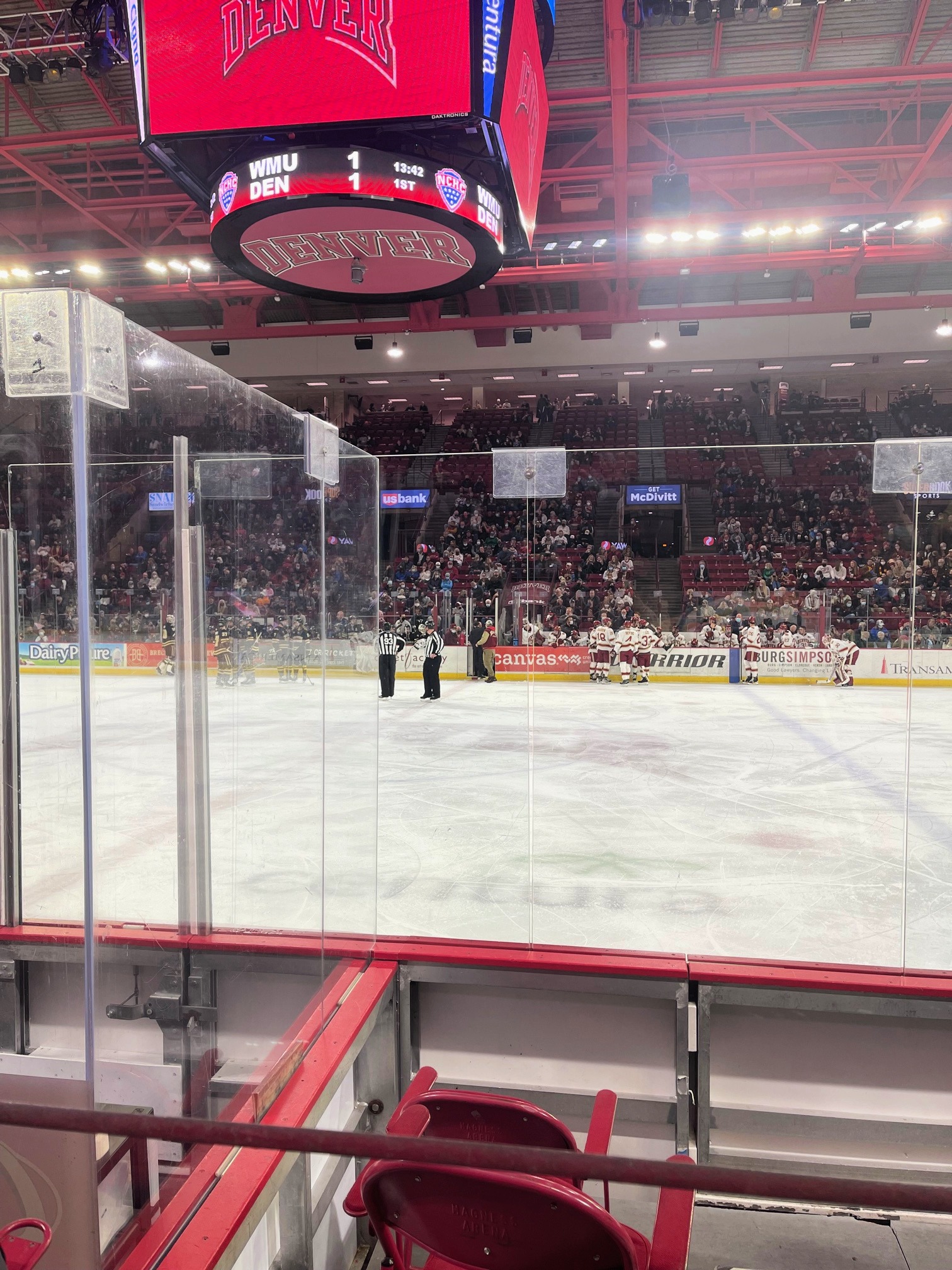© 2026 ALLCITY Network Inc.
All rights reserved.

Defenseman Sean Behrens is in his first year at the University of Denver after he was selected 61st overall in the 2nd round of the 2021 NHL draft by the Colorado Avalanche. With the opportunity to watch the Pioneers’ series against WMU this last weekend, I was able to see his game up close in a high-scoring, undisciplined match-up.
To be clear, his game is controlled and not lacking discipline, but with 20 minor penalties between both teams, I had a terrific extended look at both DU’s power play and penalty kill – Behrens is utilized on both. I saw quickly how he attacks every inch of the ice and all the makings of a multi-dimensional player.
Denver ranks within the top 10 powerplays in the country and Behrens has carved out an undeniably potent role on that unit. He has 10 points in 10 games, seven of which came on the powerplay. It is no surprise that he’s a lock on PP1. It’s especially on the powerplay where his hockey IQ shines.
So what’s Denver’s secret to such a consistent powerplay? Head coach David Carle attributed the success to assistant coach Dallas Ferguson.
“[He] works with our powerplay and I think the biggest thing is just real good puck movement,” Carle explained. “Snapping it around and moving it to the right guy at the right time and then not being afraid to shoot the puck.”
Behrens reiterated the importance of keeping it simple.
“We have all the skill in the world with Bob and Sav on the flanks and then Gutter and Maze in front,” Behrens told me, praising his teammates just a few feet away getting ready for practice at Magness Arena. “So I think just keeping it simple, moving pucks quick, [and] outworking the penalty kill has been really big for us; and when we do that, we’ve had a lot of success.”
Keeping it simple is a recurring theme in all of hockey, but it seems to be working for Denver’s powerplay quite effectively. It all comes down to understanding a common vision. Some may even describe this as a Process – more on this in a bit.
Behrens is fun to watch even in 5-on-5 scenarios because he plays with an obvious excitement to generate offensive opportunities. There’s an eagerness to Behrens’ game.
“His eyes are always up,” Carle added. “His brain’s processing allows him to play fast and [it] leads into real good transition hockey for us.”
I can see his head turning on a swivel as if eavesdropping on the conversation happening in the offensive zone, but he displays the patience to remain in position with a readiness to step into the play purposefully.
He recognizes his role to tend to business as a defenseman first but is subtly looking for an opportunity to ambush the play with crisp passing to create transition hockey.
It’s that same patience and calm that reveals the little details of his game as well. Of the defensive pairings, Behrens and his partner Kyle Mayhew were two of the only pairs to remain intact both nights. From night one into night two, Behrens’ pair emerged as one of the top pairs for the weekend.
“They don’t over-complicate their puck game as far as breakouts and neutral zone play so they don’t have to spend a lot of time in their own end oftentimes because their gaps’ really good and they make a good first outlet pass,” Carle said. “And if you do those two things, you get to play in the o-zone a little bit more.”
I saw that smart, simple hockey in Behrens’ game. Small things like nearing the bench for a change after a long shift and seeing the opportunity to break up a play in the neutral zone for a renewed scoring opportunity. He doesn’t cut corners.
Behrens fits the mold of a compact, two-way puck-moving defenseman at 5’9” 178 lbs. DU and the Colorado Avalanche are no strangers to this type of player. Hobey Baker Award winner Will Butcher benefitted from Denver’s defensive system, especially during his last seasons with DU.
Butcher emerged as quite an offensive threat, and I see similarities in their style of play already in Behrens’ first year. While there was a time that the Colorado Avalanche was keen on Butcher, it just wasn’t in the cards and the DU captain opted to test free agency instead.
Behrens is a renewed chance to fine-tune this type of player within a similar system albeit under Carle’s direct leadership this time (Carle was an assistant on DU’s staff during Butcher’s tenure).
How does Behrens continue to elevate his game to prepare himself for the next level?
“He’s gonna have to be able to transport pucks with his feet and his brain for easy breakouts and transitional play and then be able to take away time and space with his feet,” Carle said.
Behrens keeps his stance low and mobile. His skates appear almost rooted into the ice. He absorbs hits well and is unafraid to take on the battles in the corner and it’s clear why – he’s sturdy physically and uses effective stick checks to avoid additional physical contact.
For much of his game, executing checks was largely unnecessary because his skillful reads anticipated opposing skaters’ moves. It’s that hockey IQ (also seen on the powerplay) that grants Behrens a unique type of speed by playing several steps ahead of his peers.
I had to know how The Process and its legacy has continued on in the current program – specifically with regard to Denver’s d-corps. While it’s no longer seven items as it was under Jim Montgomery’s leadership, a simplified five key facets of the game emerged as the new, modified process still used to this day. Three of the five lean on Denver’s defense:
- Three or fewer odd-man rushes.
- Battle the net fronts.
- No bad penalties.
The Process delivered Logan O’Connor to the Colorado Avalanche and with these regimented, disciplined principles, Behrens is in great hands developmentally. Deciding to play at DU was an easy choice for him.
“I chose DU because of the culture here,” Behrens said. “It’s really a historic program. They play the game the right way. I thought their systems really fit my game. That really helped my choice to come here. That along with the coaching staff and it being a hockey school were all really key factors for me coming here, and I think it’s been 100% the right decision.”
What is it about Denver’s systems that really fits his game? What is the overarching identity of Denver’s defense? According to Behrens, it breaks down to these five things:
- Being hard to play against.
- Minding the gap.
- Shutting plays down before opponents enter the zone.
- Transitioning pucks quickly.
- Being able to jump in the rush.
It is believed that honoring these tenets creates teamwide success and sets a standard for Denver’s entire defense.
Unsurprisingly, when asked about the areas of his game that he’d like to focus on, Behrens shared a similar response.
“My shot, some of my D-zone boxouts, and closing out guys quickly. I think those couple of things could take my game to the next level and make me a really successful player.”
The compatibility of Behrens’ aims and Denver’s defensive standards certainly unveils a mutually beneficial relationship.

DU isn’t the sole reason Colorado receives high praise from Behrens. To be selected by the Colorado Avalanche holds a memorable place in his eyes too.
“Knowing that I was coming here, knowing that I want to be in the state of Colorado – I think that was something that’s really special for me and something that I’m gonna cherish for a long time.”
Seeing him utilized on special teams and noting his pairs’ top minutes, it’s no surprise that the NHL players he models his game after play with similar tenacity.
“[On Torey Krug] I love to watch his game – how hard he plays for being a smaller guy [and] his offensive capabilities as well,” Behrens revealed. “And then also, Jared Spurgeon from the Minnesota Wild with his leadership abilities, the way he defends with his feet and with his brain – that’s something that I really take into account in my game.”
Behrens served as an alternate captain for USA’s U18 National Team. Noting the leadership component in Spurgeon’s game is an interesting piece of information to keep in mind as he continues to develop, especially if he finds himself wearing a letter at this winter’s World Junior Championship, which he is eligible for.
Sean Behrens has a real opportunity to assume even more responsibility in his future at DU. He’s already Denver’s Swiss Army Knife as a Freshman and by every account, from Behrens himself to his head coach, there is a clear plan in place to further elevate the important elements of his game.
Comments
Share your thoughts
Join the conversation




